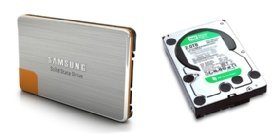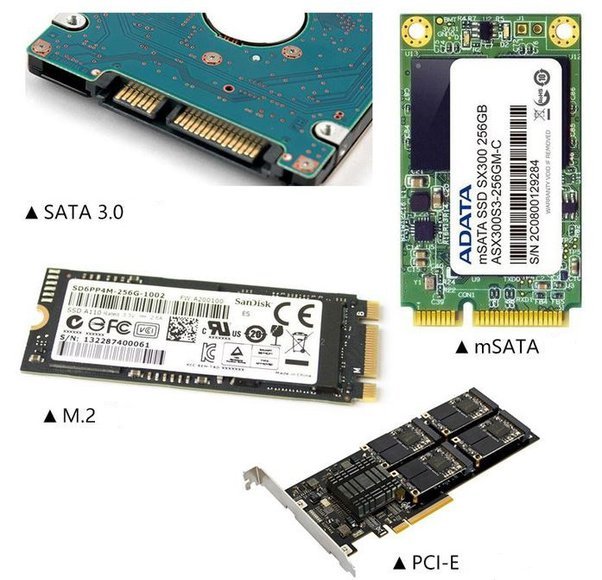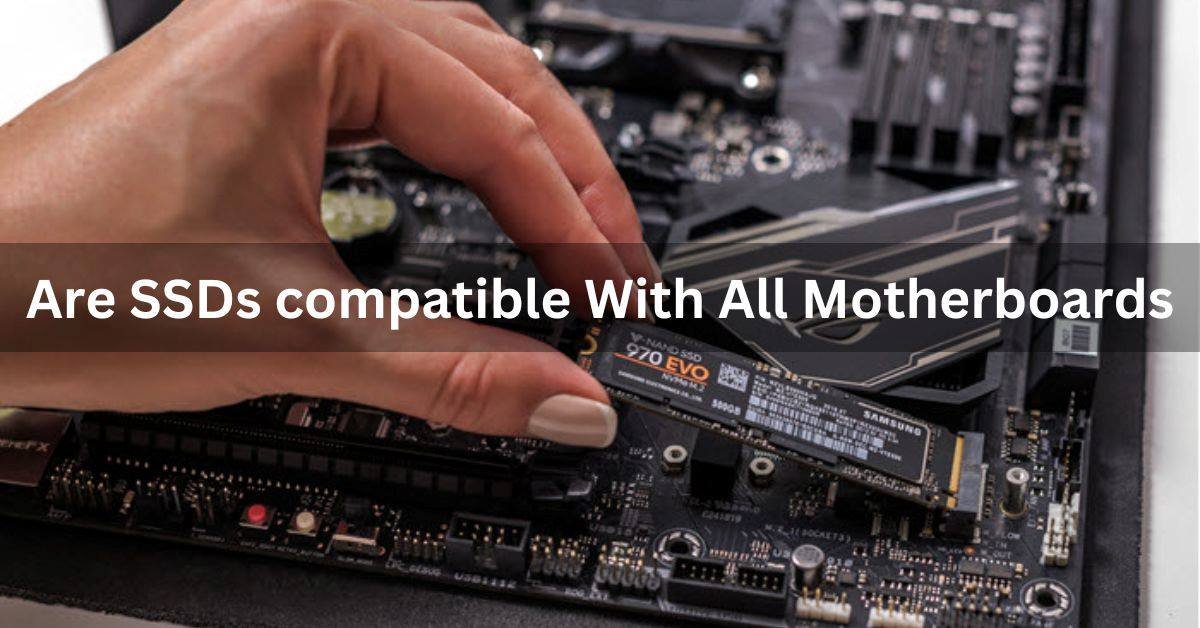Solid State Drives (SSDs) have become increasingly popular due to their speed, reliability, and energy efficiency. However, many users often wonder whether SSDs are compatible with all motherboards.
Yes, SSDs are compatible with most modern motherboards. Just make sure your motherboard has a compatible interface like SATA or NVMe for the SSD to work properly.
In this article, we will discuss motherboard compatibility and also discuss “Are SSDs compatible With All Motherboards”.
Introduction:
SSDs have revolutionized storage technology by offering faster data access and transfer speeds compared to traditional Hard Disk Drives (HDDs).
As more users transition to SSDs, understanding their compatibility with different motherboard configurations becomes crucial.
What is an SSD?

Before delving into compatibility, let’s understand what SSDs are. SSDs, or Solid State Drives, are storage devices that use flash memory to store data.
Unlike HDDs, which rely on spinning disks, SSDs have no moving parts, resulting in faster performance and increased durability.
Types of SSDs:
There are primarily two types of SSDs: SATA SSDs and NVMe SSDs.
1. SATA SSDs:
SATA SSDs connect to the motherboard via a SATA interface, which is commonly found in older systems. While SATA SSDs offer significant speed improvements over HDDs, they are limited by the SATA interface’s bandwidth.
2. NVMe SSDs:
NVMe (Non-Volatile Memory Express) SSDs utilize the PCIe interface, offering substantially higher speeds compared to SATA SSDs. NVMe SSDs are ideal for modern systems that support PCIe-based storage.
Compatibility Factors:
When determining SSD compatibility with a motherboard, several factors need consideration:
1. Interface Compatibility:
The interface of the SSD must match the interface supported by the motherboard. For example, if the motherboard supports SATA and NVMe interfaces, it can accommodate both SATA SSDs and NVMe SSDs.
2. Form Factor Compatibility:
SSD form factor, such as 2.5-inch or M.2, must align with the motherboard’s form factor and available slots. Mismatched form factors may render the SSD incompatible with the motherboard.
3. BIOS/UEFI Compatibility:
The motherboard’s BIOS or UEFI firmware must support the SSD’s interface and form factor. In some cases, updating the motherboard’s firmware may be necessary to ensure compatibility.
Read: Can I Use 2400mhz RAM in 3200mhz Motherboard – Complete Guide!
How do I know if my SSD is compatible with my motherboard?
To determine SSD compatibility with your motherboard, check the motherboard’s specifications or manual. Look for supported interfaces (SATA, NVMe) and form factors (2.5-inch, M.2) to ensure compatibility with your SSD.
Will any SSD fit into my motherboard?
Not necessarily. Whether an SSD will fit into your motherboard depends on factors like the interface (SATA, NVMe) and the type of slot (2.5-inch, M.2). Check your motherboard’s specifications to ensure compatibility.
Will any SSD or storage fit on any motherboard?
Not all SSDs or storage devices will fit on any motherboard. Compatibility depends on factors like the motherboard’s supported interfaces (SATA, NVMe) and physical slots (2.5-inch, M.2), so check specifications before purchasing.

Read: Motherboard Light Is On But No Power Up – Ultimate Guide – 2024
How to know if an M.2 SSD is compatible with your motherboard?
To check M.2 SSD compatibility with your motherboard, consult the motherboard’s specifications or manual.
Look for supported SSD lengths, keying types, and interface standards (e.g., SATA or NVMe) to ensure compatibility.
Read: Msi Motherboard Error Codes – Comprehensive Guide of 2024!
What are M.2, SATA, PCIe, and NVMe?
M.2, SATA, PCIe, and NVMe are different types of interfaces used for connecting storage devices like solid-state drives (SSDs) to a computer:
1. M.2: A small form factor connector used for connecting various components including SSDs, Wi-Fi, and Bluetooth cards directly to the motherboard.
2. SATA: A standard interface used for connecting storage devices like SSDs and HDDs to a computer. It’s common in older systems and offers moderate speeds.
3. PCIe: An interface used for high-speed data transfer in computers. PCIe slots can accommodate various expansion cards including SSDs for faster performance.
4. NVMe: A protocol designed specifically for SSDs that connects them to the PCIe bus. NVMe offers significantly faster speeds compared to traditional SATA connections, making it ideal for high-performance storage solutions.
Read: Can I Use 1866mhz Ram On 1600 Motherboard – Ultimate Guide
How to check M.2 SSD compatibility?
To check M.2 SSD compatibility, consult your motherboard’s specifications or manual. Look for details on supported SSD types, lengths, and keying.
Additionally, you can verify compatibility by checking the SSD’s specifications to ensure it matches the supported standards of your motherboard.
Read: Can I Use 3200mhz Ram In 2933mhz Motherboard – Complete Guide!
What type of SSD do you need?
To determine the type of SSD you need, consider your computer’s specifications and requirements.
Check if your motherboard supports SATA or NVMe SSDs, and choose the form factor (2.5-inch or M.2) that fits your system. Ensure compatibility for optimal performance and installation ease.
Read: What Is T Sensor On Motherboard – Complete Guide – 2024
SSD compatibility with Motherboard:
SSD compatibility with a motherboard depends on whether the motherboard supports the SSD’s interface (SATA or NVMe) and form factor (2.5-inch or M.2).
Check the motherboard’s specifications or manual to ensure compatibility with the SSD you want to use in your system.
Read: Do You Plug Your Monitor Into Graphics Card Or Motherboard – Ultimate Guide!
Motherboard and SSD compatibility check:
A motherboard and SSD compatibility check ensures that the SSD you want to use is compatible with your motherboard.
It involves verifying if the motherboard supports the SSD’s interface (e.g., SATA or NVMe) and form factor (e.g., 2.5-inch or M.2).
Read: Can Motherboard Bottleneck CPU – Complete Guide – 2024
M.2 SSD Compatibility Checker:
An M.2 SSD compatibility checker is a tool or resource that helps determine if a specific M.2 solid-state drive (SSD) is compatible with a motherboard or system based on factors like interface, length, and keying.
Read: Motherboard Yellow Light – Complete Guide – 2024
Motherboard Storage Compatibility:
Motherboard storage compatibility refers to whether a motherboard supports various storage devices such as hard disk drives (HDDs), solid-state drives (SSDs), or NVMe drives, and if it can accommodate them physically and functionally.
Compatible SSD For My Laptop:
To find a compatible SSD for your laptop, check its specifications or manual for supported SSD types and sizes.
Look for SSDs with the same interface as your laptop’s current drive (e.g., SATA or NVMe) and ensure the physical size matches your laptop’s storage bay.
Read: Do Motherboards Come With Wifi – Complete Guide – 2024
SSD For Amd Motherboard:
SSDs are compatible with AMD motherboards. Ensure the SSD uses a compatible interface like SATA or NVMe, and check the motherboard’s specifications for supported SSD types and slots.
How many SSDs can my motherboard support?
To know how many SSDs your motherboard can support, check its specifications or manual. Look for the number of SATA or M.2 slots available, as each slot can typically accommodate one SSD.
How many ssd can a motherboard support?
A motherboard can support multiple SSDs, usually ranging from 2 to 6, depending on the model. SSDs are like storage boxes for your computer, and the motherboard is like the manager that decides how many boxes it can handle.
Is any ssd compatible with any motherboard?

Not every SSD is compatible with every motherboard. You need to check if the SSD matches the motherboard’s interface, like SATA or NVMe. It’s like making sure your key fits the right lock.
Can any ssd fit in any motherboard?
Not every SSD can fit into every motherboard. You have to match the SSD’s physical size, like 2.5-inch or M.2, with the motherboard’s slots. It’s like finding the right puzzle piece to fit into the board.
Do all motherboards support ssd?
Not all motherboards support SSDs. Some older or budget models may lack the necessary connections for SSDs. It’s like some cars have cupholders while others don’t—different features for different models.
How to know if ssd is compatible with motherboard?
To check SSD compatibility with a motherboard, first identify the SSD’s interface (like SATA or NVMe) and physical size (like 2.5-inch or M.2).
Then, refer to the motherboard’s specifications to see if it supports that interface and has corresponding slots. It’s like matching puzzle pieces for a perfect fit.
Does any ssd work with any motherboard?
Not every SSD will work with every motherboard. You need to ensure compatibility by checking if the SSD’s interface (like SATA or NVMe) matches the motherboard’s supported interfaces, and if the physical size (like 2.5-inch or M.2) fits into the available slots. Compatibility is key for smooth operation.
Are all motherboards compatible with ssd?
Not all motherboards are automatically compatible with SSDs. It depends on the motherboard’s specifications and features.
Some older or budget models may lack support for SSDs, while newer ones typically do. Checking the motherboard’s documentation or specifications is key to ensuring compatibility with SSDs.
Does every motherboard support ssd?
Not every motherboard automatically supports SSDs. While many modern motherboards do support SSDs, older or budget models may lack compatibility.
It’s important to check the specifications or documentation of the motherboard to confirm if it supports SSDs before purchasing or installing one.
How many ssd can my motherboard support?
To know how many SSDs your motherboard can support, check its specifications or documentation. Most motherboards can support multiple SSDs, typically ranging from 2 to 6, depending on the model. It’s important to verify this information to ensure compatibility and avoid any issues.
Are all hdd compatible with all motherboards?
Not all HDDs are automatically compatible with all motherboards. Compatibility depends on factors like the HDD’s interface (such as SATA or IDE) and the motherboard’s supported interfaces and connectors.
Checking the specifications of both the HDD and motherboard is essential to ensure compatibility before installation.
How to know if m.2 ssd is compatible with motherboard?
To check compatibility between an M.2 SSD and a motherboard, first, identify the SSD’s key type (like B, M, or B&M) and the motherboard’s M.2 slot key type.
Then, ensure the motherboard supports the SSD’s interface (like PCIe or SATA). Consult the motherboard’s specifications for compatibility information.
Can you connect SSD to any motherboard?
Yes, you can connect an SSD to most motherboards. As long as the motherboard has compatible ports, like SATA or M.2, you can attach the SSD. Just make sure to check the specifications of both the SSD and motherboard to ensure compatibility before connecting.
Are all M-2 SSDs compatible with all motherboards?
Not all M.2 SSDs are compatible with all motherboards. Compatibility depends on factors like the type of M.2 slot (SATA or NVMe) and the motherboard’s supported interface (PCIe version).
Always check the motherboard’s specifications to ensure compatibility before purchasing an M.2 SSD.
Are SSD compatible with everything?
Yes, SSDs (Solid State Drives) work with most devices like laptops, desktop computers, and gaming consoles.
They replace traditional hard drives, offering faster performance. Just check if your device supports SSD connections like SATA or NVMe. SSDs are widely compatible and easy to install for better storage and speed.
Do all SSDs work with all PCs?
No, not all SSDs work with all PCs. Compatibility depends on factors like the SSD’s interface (SATA or NVMe) and the PC’s support for that interface. Check your PC’s specifications for compatibility with SSDs.
Are all M 2 SSDs compatible with all motherboards?
No, not all M.2 SSDs are compatible with all motherboards. Compatibility depends on the motherboard’s M.2 slot type (e.g., SATA or NVMe) and physical size (e.g., M.2 2280). Check your motherboard’s specifications for compatibility.

Can you swap SSD between motherboards?
Yes, you can swap an SSD between motherboards as long as both motherboards support the same interface (SATA or NVMe). Ensure compatibility and backup important data before making the switch.
Can I use SSD in any laptop?
Yes, you can use an SSD in most laptops. However, it’s essential to ensure compatibility with your laptop’s interface (SATA or NVMe) and physical size (2.5-inch or M.2) before purchasing an SSD.
Read: Green Light Motherboard – Complete Guide – 2024
FAQs:
1. Does this motherboard support an SSD?
Yes, this motherboard supports SSDs. Check the motherboard’s specifications or manual to confirm compatibility with SSDs. Look for supported interfaces such as SATA or NVMe to ensure compatibility with your SSD.
2. How do I know if my motherboard is compatible with SSD?
To check SSD compatibility with your motherboard, review the motherboard’s specifications or manual. Look for supported interfaces like SATA or NVMe. If your motherboard supports these interfaces, it’s likely compatible with SSDs.
3. How do I connect my SSD to my motherboard?
To connect your SSD to your motherboard, first locate the SATA or NVMe slot on the motherboard. Then, insert the SSD into the slot firmly. Secure it with screws if necessary. Finally, connect the appropriate cables for power and data transfer.
4. Does an SSD work with any motherboard?
Yes, SSDs can work with most modern motherboards. However, it’s essential to ensure your motherboard has compatible interfaces like SATA or NVMe to support the SSD for proper functionality.
5. What kind of SSD is compatible with any motherboard?
SSDs with SATA interfaces are compatible with most motherboards. SATA SSDs are widely supported and can be used with virtually any motherboard that has SATA ports. Ensure your motherboard has SATA ports for compatibility.
6. How do I know if an SSD disk can be used with my motherboard?
To determine SSD compatibility with your motherboard, check the motherboard’s specifications or manual for supported interfaces such as SATA or NVMe. Ensure the SSD you choose matches these interface requirements to ensure compatibility.
7. What SSD drive is compatible with an H87ME motherboard?
For an H87ME motherboard, SSDs with SATA or PCIe interfaces are compatible. Look for SSDs labeled as SATA or NVMe to ensure compatibility. Consult the motherboard’s specifications or manual for further guidance on supported SSD types.
8. How can I make sure my SSD is compatible with my motherboard?
To ensure SSD compatibility with your motherboard, check if your motherboard has the appropriate interface (SATA or NVMe) for the SSD. Refer to the motherboard’s specifications or manual for confirmation.
9. Is the GA-B85M-DS3H-A motherboard compatible with SSD’s?
Yes, the GA-B85M-DS3H-A motherboard is compatible with SSDs. It supports SATA connections, allowing you to install SATA SSDs for improved storage performance.
10. Can I use PCIe SSD for any motherboard?
No, not all motherboards support PCIe SSDs. Make sure your motherboard has a PCIe slot and supports NVMe or SATA protocols for compatibility with PCIe SSDs.
Conclusion:
In conclusion, most modern motherboards support SSDs, but compatibility depends on matching interfaces like SATA or NVMe. Check your motherboard’s specifications to ensure your SSD fits. Remember, not all SSDs will work with every motherboard, so it’s crucial to verify compatibility before purchase. Make sure to choose the right SSD type and form factor for optimal performance and ease of installation.
